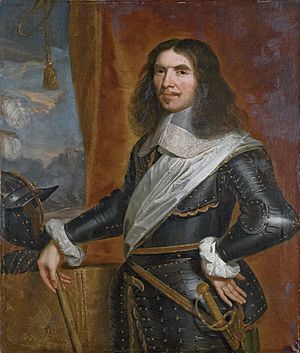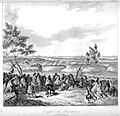Battle of Sinsheim facts for kids
Quick facts for kids Battle of Sinsheim |
|||||||
|---|---|---|---|---|---|---|---|
| Part of Franco-Dutch War | |||||||
 Turenne's command post at Sinsheim |
|||||||
|
|||||||
| Belligerents | |||||||
| Commanders and leaders | |||||||
| Strength | |||||||
| 1,500 infantry, 6,000 cavalry | 1,500 infantry, 7,000 cavalry | ||||||
| Casualties and losses | |||||||
| 1,100–1,500 killed or wounded | 2,000+ killed Unknown wounded 500 to 600 captured |
||||||
The Battle of Sinsheim happened on June 16, 1674. It took place near a town called Sinsheim in what is now Germany. This battle was part of the Franco-Dutch War (1672-1678). A French army, led by Marshall Turenne, fought against an Imperial army. The Imperial army was from the Holy Roman Empire and was led by Aeneas de Caprara. The French won this battle.
The war started in May 1672 when France invaded the Dutch Republic. By August 1673, the Dutch had made an alliance with Emperor Leopold. This opened a new fighting area in the Rhineland, a region along the Rhine River. For the 1674 fighting season, Turenne's job was to stop Imperial troops from entering Alsace, a disputed area. He faced several enemy forces that were larger than his own. So, he planned to defeat them one by one.
On June 16, 1674, Turenne caught an Imperial group of about 8,500 soldiers. They were on their way to join their main army near Heidelberg. Caprara's troops fought back against the first two French attacks. But then they had to retreat. Turenne couldn't stop them from joining the main Imperial army. However, he caused heavy losses to Caprara's forces. This gave Turenne an important advantage for the rest of the campaign.
Why the Battle Happened
The Franco-Dutch War began in May 1672. French troops quickly took over much of the Dutch Republic. But by July, the Dutch managed to stabilize their defenses. The French king, Louis XIV, became too demanding because of his early success. Other countries worried about France's growing power. This led the Dutch to get help from Brandenburg-Prussia, Emperor Leopold, and Charles II of Spain.
In August 1673, the French army in the Rhineland, led by Turenne, faced Imperial forces. These forces were under Raimondo Montecuccoli. Montecuccoli outsmarted Turenne and helped the Dutch capture the city of Bonn in 1673. France was now fighting on many fronts. So, King Louis gave up most of his early gains. He wanted to strengthen France's borders with the Spanish Netherlands and in the Rhineland.
In January 1674, Denmark joined the countries fighting France. Then, in February, the Treaty of Westminster ended the Third Anglo-Dutch War. This meant England stopped fighting the Dutch. The allies decided to focus on pushing France out of the Netherlands. An Imperial army also planned to open a second front in Alsace.
King Louis made Turenne the commander in Alsace. He ordered Turenne to stop the Imperial forces from entering eastern France. He also had to prevent them from joining up with the Dutch. Turenne knew he wouldn't get more soldiers. The longer he waited, the worse his situation would become. So, he decided to attack first. French armies at this time had some big advantages. They had one clear leader, skilled generals, and much better ways to get supplies. Changes made by Louvois, the French Secretary of War, meant they could get ready for war faster. They could also fight for longer periods than their enemies.
For 1674, France's main goals were to take back the Franche-Comté region. They also wanted to secure important forts along their border with the Spanish Netherlands. Turenne's job was to keep the Imperial forces out of Alsace. But he believed the best way to do this was to go on the offensive. On June 14, he crossed the Rhine River near Philippsburg. He wanted to stop an Imperial force under Aeneas de Caprara. He hoped to fight them before they could join up with Alexander von Bournonville's army. On June 16, Turenne found Caprara outside Sinsheim and started the battle.
The Battle of Sinsheim
Caprara's soldiers, mostly foot soldiers, lined up along the hedges and gardens. These were at the entrance of the village of Sinsheim.
Turenne's foot soldiers and dragoons (soldiers who could fight on horseback or on foot) attacked. They pushed past the enemy outposts. Then they crossed a small river called the Elsanz and entered Sinsheim. The Imperial soldiers retreated through the village. They fell back to a flat area, or plateau, behind the village.
To reach this plateau, the French had to go through a narrow path. Turenne placed his foot soldiers and dragoons in the hedges on both sides of this path. He also put soldiers in the castle and in the nearby vineyards. This allowed the French cavalry (soldiers on horseback) to move forward through the narrow passage.
The enemy tried to counter-attack. But the French foot soldiers fired at them, stopping their advance. The Imperial forces were pushed off the plateau and had to retreat. Turenne immediately left Sinsheim after the battle. He went to keep an eye on the main Imperial army, which was located near the Moselle River.
Reports say that between 2,000 and 3,000 soldiers died in the battle. The city of Sinsheim was completely destroyed.
What Happened Next
The Battle of Sinsheim was only a small victory for Turenne. This was because both enemy forces still managed to join together near Heidelberg.
On July 1, the Elector of Brandenburg also started fighting against France. The Perpetual Diet of Regensburg, a big meeting of leaders from the Holy Roman Empire, officially declared war on France.
Turenne crossed the Rhine River again. He then damaged the Palatinate region in July 1674. This stopped the Imperial forces from having enough supplies to attack Alsace.
Images for kids




